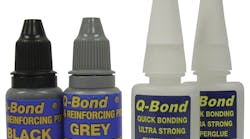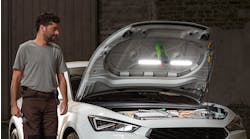The KTI Q-Bond, No. KTI90002, quick-bonding adhesive changes from liquid to rock-solid in 10 seconds, according to the company. Besides the liquid adhesive, there is a two-part system which utilizes the liquid glues combined with powders to create reinforcing and filling capabilities. This product is used to fill in breaks, cracks, holes and gaps in plastics and metals. The repairs can then be ground, filed, sanded and painted to regain its original shape. The Q-Bond kit includes two bottles of Q-Bond adhesive (0.35oz/10ml), one bottle black reinforcing powder for plastics, and one bottle grey reinforcing powder for metals.
The Review
Lou Fort, lead technician at K.A.R.S. Inc. in Huntingburg, Ind., recently reviewed the KTI Q-Bond quick-bonding adhesive. He describes it as a life and money saver more than a time saver. “Q-Bond allows you to patch things rather than replace them,” he says.
The Q-Bond Kit, No. KTI90002, comes packaged in a cardboard box with images that show the user common applications for the product. Fort says the kit came with two ‘pins’ used to open and seal the bottles of adhesive; a pair of small tips for fine/delicate repairs; a QR code that when scanned brings up an e-mail address, a thank you message and a phone number. An instruction pamphlet is also included.
Before using the Q-Bond, Fort referred back to the included pamphlet. “Just to make sure I understood how to use the product properly,” he says. “There a few simple things that have to be done when using Q-Bond to ensure you’re making the best repair possible.”
Fort says the most important thing a technician can do is to make sure the repair site has been roughed up, and is clean and dry. “Any contamination and the repair will either fail or, at best, be weak.”
To ensure that users achieve the best results, Fort says they must also choose which filler will work best for the specific repair. He says, “Fill the crack/void with ‘fill powder’ then drip the adhesive onto the powder until full. Some repairs will require you to make a ‘dam’ of sorts with tape to hold the filler in place before adding in the adhesive.”
Fort says the product’s ease of use depends on the user’s skill and/or patience. “The more you use it, the easier it becomes to use.”
Fort used the Q-Bond to patch distributor caps, air filter housings, radiator overflow nipples, interior and exterior trim panels and more. He has also used it to repair tools. “Just last week I used it to put the handle back together on my very old angle grinder.”
The best thing about the Q-Bond, according to Fort, are the fill powders. “These powders allow me to make repairs other adhesives don’t. I also like that once you have your part prepped and have added the adhesive it is ‘rock hard’ in around 10 seconds.”
He didn’t like that the product doesn’t work with wood. Although, he adds, the product doesn’t claim to work on wood.
Having used this product for years, Fort says he didn’t notice anything different with this kit over others. As an improvement, he suggests that the company should develop a tint or dye that could be added to the fill powders as a way to change the color for the applicable repair. He says, “Outside of having a tinting option, having a selection of powders in different colors would help make better-looking repairs when working on trim panels, dashboards and the like.” He also adds that the QR code could link to a website or usage video.
Fort gives the KTI Q-Bond a 10, on a scale of one to 10. He says, “It has never failed to make the repair I was hoping it would, when I have used it as intended. There have even been a few (repairs) I wasn’t sure it would work, but (Q-Bond) ended up holding just fine.”




